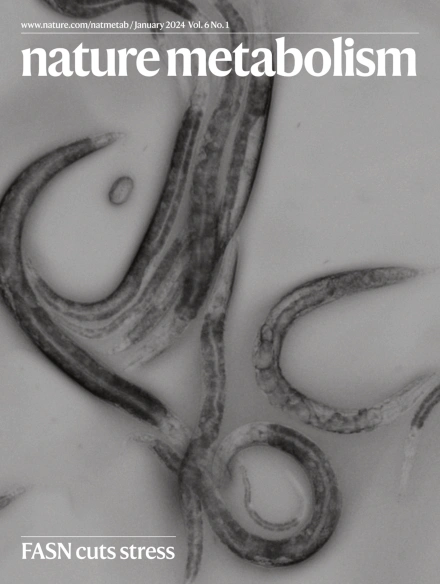肝细胞中的非凋亡caspase-8-meteorin通路促进MASH纤维化。
IF 20.8
1区 医学
Q1 ENDOCRINOLOGY & METABOLISM
引用次数: 0
摘要
代谢功能障碍相关脂肪性肝炎(MASH)是慢性肝病的主要原因,但对MASH诱导的肝纤维化的不完全了解限制了治疗选择。在这里,我们表明肝细胞caspase-8通过一种不依赖于凋亡的机制驱动MASH纤维化。在人和实验性MASH中,肝脏caspase-8表达与肝纤维化相关,而在患有MASH的雄性小鼠中,肝细胞特异性caspase-8缺失抑制了肝纤维化和肝星状细胞(HSC)活化,而不影响肝细胞凋亡。机制研究表明,肝细胞中的caspase-8-YY1通路诱导分泌性气象蛋白(Metrn),其通过c-Kit-STAT3通路激活hsc。在人类和雄性小鼠的MASH肝脏中,Meteorin的表达增加,而在人类和小鼠的原代肝细胞中,通过缺失肝细胞caspase-8来降低。在肝细胞caspase-8缺失的MASH小鼠中,肝细胞流星蛋白的遗传恢复恢复了HSC的激活和肝纤维化,而沉默肝细胞流星蛋白则降低了肝纤维化。这些发现揭示了一种促进MASH纤维化的治疗可靶向途径,涉及caspase-8和新发现的HSC激活剂meteorin的非凋亡功能。本文章由计算机程序翻译,如有差异,请以英文原文为准。

A non-apoptotic caspase-8–meteorin pathway in hepatocytes promotes MASH fibrosis
Metabolic-dysfunction-associated steatohepatitis (MASH) is the leading cause of chronic liver disease, but an incomplete understanding of MASH-induced liver fibrosis has limited therapeutic options. Here we show that hepatocyte caspase-8 drives MASH fibrosis through an apoptosis-independent mechanism. Hepatic caspase-8 expression correlates with liver fibrosis in both human and experimental MASH, and hepatocyte-specific caspase-8 deletion in male mice with MASH suppressed liver fibrosis and hepatic stellate cell (HSC) activation without affecting hepatocyte apoptosis. Mechanistic studies showed that a caspase-8–YY1 pathway in hepatocytes induces secretory meteorin (Metrn), which activates HSCs via a c-Kit–STAT3 pathway. Meteorin expression was increased in human and male mouse MASH livers and decreased by deletion of hepatocyte caspase-8 in MASH mice and human and mouse primary hepatocytes. Genetic restoration of hepatocyte meteorin in hepatocyte-caspase-8-deleted MASH mice restored HSC activation and liver fibrosis while silencing hepatocyte meteorin lowered liver fibrosis. These findings reveal a therapeutically targetable pathway promoting MASH fibrosis involving a non-apoptotic function of caspase-8 and a newly discovered HSC activator, meteorin. Hepatocyte caspase-8 in MASH promotes the activation of hepatic stellate cells and liver fibrosis through an apoptosis-independent mechanism
求助全文
通过发布文献求助,成功后即可免费获取论文全文。
去求助
来源期刊

Nature metabolism
ENDOCRINOLOGY & METABOLISM-
CiteScore
27.50
自引率
2.40%
发文量
170
期刊介绍:
Nature Metabolism is a peer-reviewed scientific journal that covers a broad range of topics in metabolism research. It aims to advance the understanding of metabolic and homeostatic processes at a cellular and physiological level. The journal publishes research from various fields, including fundamental cell biology, basic biomedical and translational research, and integrative physiology. It focuses on how cellular metabolism affects cellular function, the physiology and homeostasis of organs and tissues, and the regulation of organismal energy homeostasis. It also investigates the molecular pathophysiology of metabolic diseases such as diabetes and obesity, as well as their treatment. Nature Metabolism follows the standards of other Nature-branded journals, with a dedicated team of professional editors, rigorous peer-review process, high standards of copy-editing and production, swift publication, and editorial independence. The journal has a high impact factor, has a certain influence in the international area, and is deeply concerned and cited by the majority of scholars.
 求助内容:
求助内容: 应助结果提醒方式:
应助结果提醒方式:


